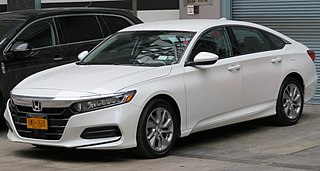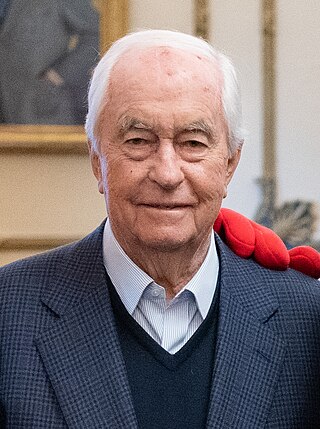Related Research Articles

Eagle was a brand of the Chrysler Corporation following the purchase of American Motors Corporation (AMC) in 1987 and marketed through the end of the 1998 model year. It was aimed at the enthusiast driver and promoted as more "European" than the automaker's similar models.

American Motors Corporation was an American automobile manufacturing company formed by the merger of Nash-Kelvinator Corporation and Hudson Motor Car Company on May 1, 1954. At the time, it was the largest corporate merger in U.S. history.

The Detroit Auto Show, formerly known as the North American International Auto Show (NAIAS), is an annual auto show held in Detroit, Michigan. Hosted at Huntington Place since 1965, it is among the largest auto shows in North America, and is widely regarded as one of the automotive industry's most important events.

Autoweek is a car culture publication and magazine based in Detroit, Michigan. It was first published in 1958 and in 1977 the publication was purchased by Crain Communications Inc, its current brand licensor. The magazine was published weekly and focused on motor sports, new car reviews, and old cars, events and DIY. Autoweek now publishes Autoweek.com. Autoweek brand is owned by Crain Communications Inc., publisher of leading industry trade publications Advertising Age and Automotive News, among others, and is based in Detroit, Michigan.

The Renault Alliance is a front-wheel drive, front-engine subcompact automobile manufactured and marketed in North America by American Motors Corporation (AMC) for model years 1983–1987. The Alliance and its subsequent hatchback variant, the Encore, were re-engineered Renault 9 & 11 for the U.S. and Canadian markets.

The Eagle Premier is a full-size executive car that was developed by American Motors Corporation (AMC) during the 1980s through its partnership with Renault. This model was manufactured in the then-brand-new Brampton Assembly in Canada.

Mid-size—also known as intermediate—is a vehicle size class which originated in the United States and is used for cars larger than compact cars and smaller than full-size cars. "Large family car" is a UK term and a part of the D-segment in the European car classification. Mid-size cars are manufactured in a variety of body styles, including sedans, coupes, station wagons, hatchbacks, and convertibles. Compact executive cars can also fall under the mid-size category.

Full-size car—also known as large car—is a vehicle size class which originated in the United States and is used for cars larger than mid-size cars. It is the largest size class for cars. In the United Kingdom, this class is referred to as the executive car, while in Europe, it is known as E-segment or F-segment.

Roger Searle Penske is an American auto racing team owner, businessman, and retired professional driver. Penske is the owner of Team Penske, the Indianapolis Motor Speedway, IndyCar, and other auto racing-related businesses. Penske is the founder and chairman of the Penske Corporation, a holding company for his various businesses. Penske is also a Presidential Medal of Freedom recipient.
David Evan Davis Jr. was an American automotive journalist and magazine publisher widely known as a contributing writer, editor and publisher at Car and Driver magazine and as the founder of Automobile magazine.

Richard Arthur "Dick" Teague was an American industrial designer in the North American automotive industry. He held automotive design positions at General Motors, Packard, and Chrysler before becoming Vice President of Design for American Motors Corporation (AMC).

The Chrysler Turbine Car is an experimental two-door hardtop coupe powered by a turbine engine and was manufactured by Chrysler from 1963 to 1964. Italian design studio Carrozzeria Ghia constructed the bodywork, and Chrysler completed the final assembly in Detroit. A total of 55 cars were manufactured: five prototypes and a limited run of fifty cars for a public user program. All have a signature metallic paint named "turbine bronze", roughly the color of root beer. The car was styled by Elwood Engel and Chrysler studios. They featured power brakes, power steering, and a TorqueFlite transmission.
Electronic voice alert (EVA) was an option available on many Chrysler K-car-based vehicles in the mid-1980s.

The Rambler Tarpon was a concept car, a compact-sized sporty youth-oriented 2+2 hardtop coupé developed in 1963 by American Motors Corporation (AMC). The bright red with black roof design study made its public debut at the 1964 Chicago Auto Show. The car served to foretell the fastback design elements of the larger Rambler Marlin that was introduced in 1965.
Thomas Jay McCahill III (1907–1975) was an automotive journalist, born the grandson of a wealthy attorney in Larchmont, New York. McCahill graduated from Yale University with a degree in fine arts.. He is credited with, amongst other things, the creation of the "0 to 60" acceleration measurement now universally accepted in automotive testing. He became a salesman for Marmon and in the mid-1930s operated dealerships in Manhattan and Palm Springs, featuring Rolls-Royce, Jaguar, and other high-line luxury cars. The depression and his father's alcoholism wiped out his family's fortune.
Jean Jennings is a retired American journalist, publisher and television personality covering the automotive industry, noted for making the industry more accessible to a broad cross-section of enthusiasts.

The Chrysler Pacifica is a minivan produced by the Chrysler division of Stellantis. It is unrelated to the discontinued crossover and concept vehicles by the same name and replaced the Chrysler Town & Country for the 2017 model year. It is positioned as the higher-end Chrysler minivan, above the Dodge Grand Caravan until 2020 and above the Chrysler Voyager since 2020.
The term Malaise era refers to a period in the U.S. automotive industry from roughly the early 1970s through the early to mid 1980s, characterized by malaise: poor products and a generalized industry unease — an era of profound adjustment as the U.S. automotive industry adapted to meet wholly new demands for more fuel-efficient, safe and environmentally responsible products.

The Plymouth XNR is a concept car developed by Chrysler. It was designed by Virgil Exner, and first shown in 1960. Also called the XNR 500, the car is an open roadster with some asymmetric features, and was proposed as a sporty addition to the Plymouth model lineup, and as competition for the Chevrolet Corvette.

George Damon Levy is a motorsports author, speaker, and historian and former editor of the enthusiast magazine Autoweek, and current president of the Motorsports Hall of Fame of America. He has contributed to various automotive publications and websites, including Autoweek, RACER, Car and Driver and Vintage Motorsport. He is best known for his 2016 book Can-am 50th Anniversary: Flat Out with North America’s Greatest Race Series, which earned a Gold Medal in the 2017 International Automotive Media Competition. He is a frequent collaborator with his longtime friend, the late, award-winning motorsports photographer Pete Biro. Their second book, F1 Mavericks: The Men and Machines that Revolutionized Formula 1 Racing, was published in July, 2019. More books together are in development.
References
- ↑ "PM's Top Auto Spy Receives Lifetime Achievement Award: Live from the Detroit Auto Show". Popular Mechanics. September 30, 2009.
- 1 2 3 4 5 6 Thom Taylor (August 22, 2019). "Original Auto Spy Photographer–the Zany World of Jim Dunne". Motor Biscuit.
- 1 2 3 4 5 6 "Jim Dunne to Receive Lifetime Achievement Award at 2007 International Car of the Year Awards". Road and Travel. November 6, 2006.
- 1 2 3 Raphael Orlove (August 21, 2019). "Jim Dunne, The Godfather Of Car Spy Photography, Dies At 87". Jalopnik.
- 1 2 Mark Vaughn (August 20, 2019). "Jim Dunne, the father of automotive spy photography: 1931-2019". Autoweek.
- 1 2 3 Chris Tsui (November 8, 2019). "Pioneer of Automotive Spy Photography Jim Dunne Dies at 87". The Drive.
- 1 2 3 4 5 "Leo Dunne". Tribute Archive.
- 1 2 3 4 5 6 7 "Remembering Car Spy Photographer Jim Dunne". NPR. August 24, 2019.
- 1 2 3 Paul A. Eisenstein (August 21, 2019). "Jim Dunne, Legendary Automotive Spy Photographer, Dead at 87". The Detroit Bureau.
- 1 2 Tony Swann (August 20, 2019). "Meet the Man Who All But Invented Serious Car Spy Photography". Car and Driver.
- 1 2 Todd Lassa (August 20, 2010). "In Memoriam: Jim Dunne, the Father of Car Spy Photography". Motor Trend.
- 1 2 Steve Wilke (December 26, 2013). "Spy vs. Spy". Hour Detroit.
- 1 2 David C. Smith (August 21, 2019). "Jim Dunne, Wards Contributor for 30 Years". Wards.